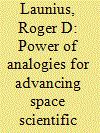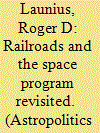|
|
|
Sort Order |
|
|
|
Items / Page
|
|
|
|
|
|
|
| Srl | Item |
| 1 |
ID:
135166


|
|
|
|
|
| Summary/Abstract |
The impact of finding life beyond Earth, whether microbial, complex, or intelligent, is an important and timely problem given recent discoveries in the field of astrobiology. Analogy is one of the tools that may be used cautiously to explore potential impacts of discovering extraterrestrial life under different scenarios. After a brief examination of the problems and promise of analogy, this article suggests four analogs useful for providing guidelines in the event of such a discovery: the microbe analogy, the culture contact analogy, the transmission/translation analogy, and the worldview analogy. We offer what we term the “Goldilocks Principle of Analogy”: analogy must not be so general as to be meaningless, nor so specific as to be misleading. As in other fields, the middle “Goldilocks” ground is where analogies may serve as useful guideposts for astrobiology and its impact. And although the discovery of life beyond Earth will be a unique event, these guidelines may be useful for policy decisions both before and after the discovery of life.
|
|
|
|
|
|
|
|
|
|
|
|
|
|
|
|
| 2 |
ID:
135165


|
|
|
|
|
| Summary/Abstract |
At the beginning of the twentieth century, geology was a terrestrial science, one that had no place making pronouncements on astronomical objects. Yet, by mid-century, this science was de rigueur in lunar studies. This article examines the heated debate, leading up to the Apollo missions, amongst geologists as to whether their discipline could tell scientists anything about the surface or composition of other celestial bodies. Precisely because the United States Geological Survey opened an Astrogeology Branch and geology education became a part of astronaut training, geologists gradually accepted the extraterrestrial application of their field and the prestige that came with it. In addition to recounting this disciplinary shift, this article considers how Earth itself became an analog for understanding the Moon. Before Neil Armstrong took his “one giant leap,” astronauts traveled with trained geologists to sites that they thought would resemble the geologic composition of the Moon. There, astronauts were trained to identify different rock types and perform “analog fieldwork” that would prepare them for the science objectives of their lunar voyage. Upon landing on the Moon, several astronauts remarked at how much the Moon looked like the American Southwest, the landscape in which they were trained. Analogy is not just a cognitive heuristics used by scientists, but it is also a technique that can be embodied and enacted, as illustrated by this case of taking geology to the Moon.
|
|
|
|
|
|
|
|
|
|
|
|
|
|
|
|
| 3 |
ID:
135160


|
|
|
|
|
| Summary/Abstract |
It is a truism that every person in every organization ever created uses history to make decisions on a daily basis. This is essentially accomplished through the use of analogy, suggesting that some issue under current scrutiny is like, may be compared to, or otherwise is related to some historical example. Understanding what happened in those past, analogous instances therefore serves a valuable purpose in considering what to do in the present. The difficulties of analogs, however, are that they are routinely poorly applied to considerations of policies, priorities, and decision making which might effectively be informed by careful analog studies. Unfortunately, most uses of historical understanding are implicit, relying on personal anecdotes and employing faulty logic in the comparison. We have certainly seen this in the context of issues concerning the exploration of the space frontier since virtually the beginning of the space age. These range from analogs comparing modern cruise ship vacations and future space tourism to using the space race between the United States and the Soviet Union of the 1960s as an analog to predict a similar space race between the United States and China.
|
|
|
|
|
|
|
|
|
|
|
|
|
|
|
|
| 4 |
ID:
135163


|
|
|
|
|
| Summary/Abstract |
While many are familiar with the enticing of American transcontinental railroad construction through land grants from national, state, and local governments, there was a range of other stimulative efforts to facilitate railroad development. These included tax breaks, investment credits, and otherwise favorable decisions supporting these business interests. They also involved, in some instances, direct subsidies; monopolies not only on railroad operations but also in ancillary and even tertiary industries; and changes to regulations to ease requirements for labor, safety, and other factors. This article examines the analogue between railroad development in the U.S. and that of space exploitation specific to access to space, involving space launch technology development, drawing several key findings from the railroad experience. It suggests that there is a broad range of options that have been pursued in the past to stimulate investment in infrastructure—in this case in railroads—that have application for future space access operations. Not all of these options were successful—some failed outright and others had detrimental unintended consequences—and that is discussed as well.
|
|
|
|
|
|
|
|
|
|
|
|
|
|
|
|
| 5 |
ID:
135161


|
|
|
|
|
| Summary/Abstract |
This article describes the manner in which advocates of mountain climbing in the Himalayas used commercialization to expand the number of persons engaged in the activity, to cut cost, and to reduce risk. To the extent that climbing into the “death zone” of mountains, like Mount Everest, constitutes an analogy to space exploration, the article suggests that advocates of spaceflight travel may be poised at the end of an expeditionary period similar to the one that afflicted mountain climbers before they made the transition to the commercial era.
|
|
|
|
|
|
|
|
|
|
|
|
|
|
|
|
| 6 |
ID:
135164


|
|
|
|
|
| Summary/Abstract |
The United States Antarctic Program (USAP) provides a revealing analogy to American spaceflight owing to its common historical origin, similar base in Cold War national security and diplomacy, and reciprocal influence of scientific research and technology development associated with Antarctica and outer space. In addition, the USAP and America’s space program have been high-profile federal endeavors, promoted by varying constituents through unifying narratives intended to elicit “public understanding” or, more pointedly, public support for these strategic national initiatives. Beginning in the late 1950s, initial narratives similarly depicted both programs as confirmation that the United States was a benevolent world power which deployed its preeminent science and technology to positively transform distant realms and make their bounty serve humankind. As domestic priorities and international affairs dramatically shifted at the end of the 1960s, public discourse about the U.S. Antarctic and space programs changed and diverged. The USAP came to embody a national commitment to protecting the global environment while American spaceflight evinces more mixed national aspirations. A comparative account of this initial convergence and ultimate divergence exposes the cultural politics of these federal initiatives and helps reveal the process by which boosters and commentators cultivated public understanding and support for these strategic national endeavors.
|
|
|
|
|
|
|
|
|
|
|
|
|
|
|
|
| 7 |
ID:
135159


|
|
|
|
|
| Summary/Abstract |
This report surveys the principal space events of 2013 and analyzes the central trends that can be discerned in government space activities in nations around the world. The article refers to cooperation between countries, to trends in space security, and reviews the space policies and activities of the leading nations as well as emerging ones. The proportion of government funds has declined in recent years; at the same time, space is one of the fields in which commercial endeavors are closely tied with government activities, and is strongly affected by the dynamics and politics between nations. The international community is struggling over the nature of activities in space, world leadership, and what should be permitted and what should be prohibited. Alongside this struggle for control and influence, many nations have come to understand that challenges and threats exist which require cooperation to address adequately. The concern is that, in the absence of appropriate action, use of space will be denied to all. The principal challenge facing the international community is to find a way to surmount obstacles to cooperation. Accordingly, follow-up and analysis of the interests, goals, and conflicts between the nations that are formulating the priorities and making the decisions about space are essential for understanding the direction in which developments in space are headed. They are also indispensable in creating a sustainable space industry.
|
|
|
|
|
|
|
|
|
|
|
|
|
|
|
|
| 8 |
ID:
135162


|
|
|
|
|
| Summary/Abstract |
The popularization of the science of space exploration in America after World War II has its roots in the nineteenth century. Mid-twentieth-century calls to “conquer” space were reanimations of nineteenth-century exhortations to “conquer” the American West in the name of God and to fulfill America’s manifest destiny. Magazine articles, television specials, and films such as Destination Moon (1950) explicitly connected the ephemeral space frontier to the historical Western frontier. In each medium, “space proselytizers,” like artist Chesley Bonestell, engineer Wernher von Braun, and writer Willy Ley, made clear connections between the American frontiersman of the previous century and the twentieth century’s space pioneer. This link is especially apparent in a series of articles on the emerging science of space exploration that ran in Collier’s magazine from 1952 until 1954. Space is viewed as “our new frontier,” and is championed through Bonestell’s paintings and von Braun’s invocation of the material frontier. Von Braun even closes his article by explaining that Americans are ready for a journey to “man’s oldest and last frontier: the heavens themselves.” Thus, the science of space exploration—in the Collier’s articles and elsewhere—was carefully framed as an endeavor analogous to the conquering of the American West. By situating space as humankind’s “last frontier,” the effort required to build a space program could become a moral endeavor and the fulfillment of America’s new manifest destiny.
|
|
|
|
|
|
|
|
|
|
|
|
|
|
|
|
|
|
|
|
|